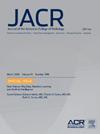选择性影像学利用的主要驱动因素的特征和目标:一项应用联合分析的横断面研究。
IF 4
3区 医学
Q1 RADIOLOGY, NUCLEAR MEDICINE & MEDICAL IMAGING
引用次数: 0
摘要
方法:在这项机构研究委员会批准的基于调查的研究中,对393名最近在过去2年内接受过肩部、腰椎或膝关节非对比MRI检查的患者和168名在过去一年中至少进行过12次此类MRI检查的医生进行了在线调查。调查数据包括关于偏好的明确问题,以及一组联合选择屏幕。联合分析利用最大似然估计估计的逻辑模型。此外,进行潜在类别分析以评估市场细分。结果:患者和转诊医生都最重视共同支付/成本,两组都包含一个很大的部分,几乎所有的价值都放在低成本上。患者也重视转诊医生的推荐和方便的预约时间和地点。总的来说,医生也重视图像质量和值得信赖的放射科医生,其中一个医生群体更重视这些特征而不是成本。正如预期的那样,根据受访者是否对特征进行排名、评级或隐含评价,特征的相对重要性之间存在一些差异。讨论:总体而言,患者和转诊医生都非常重视共同支付/成本,但其他非货币特征具有重要的实用价值,可以利用这些特征帮助放射学实践为患者和转诊医生提供更好的服务。本文章由计算机程序翻译,如有差异,请以英文原文为准。
Characterization and Targeting of the Main Drivers of Elective Imaging Utilization: A Cross-Sectional Study Applying Conjoint Analysis
Objective
To characterize patient and referring physician preferences when selecting where to have elective imaging performed.
Methods
In this institutional research board–approved survey-based study, online surveys were completed by 393 patients who had recently had a noncontrast MRI of the shoulder, lumbar spine, or knee within the past 2 years and 168 physicians who had ordered at least 12 such MRIs in the past year. The survey data included explicit questions about preferences as well as a set of conjoint choice screens. Conjoint analysis used a logistic model estimated using maximum likelihood estimation. Additionally, latent class analysis was performed to evaluate segmentation of the market.
Results
Both patients and referring physicians placed most value on copay and cost, with both groups containing a large segment that places almost all value on low costs. Patients also valued the recommendation of their referring physician and convenient appointment time and location. Overall, physicians also valued image quality and a trusted radiologist, with one physician segment placing more value on these traits than cost. As expected, there was some variation between the relative importance of traits depending on whether respondents were ranking, rating, or implicitly valuing characteristics.
Discussion
Overall, both patients and referring physicians place greatest importance on copay and cost but other nonmonetary characteristics have significant utility values, which could be leveraged to help radiology practices offer better services for their patients and referring physicians.
求助全文
通过发布文献求助,成功后即可免费获取论文全文。
去求助
来源期刊

Journal of the American College of Radiology
RADIOLOGY, NUCLEAR MEDICINE & MEDICAL IMAGING-
CiteScore
6.30
自引率
8.90%
发文量
312
审稿时长
34 days
期刊介绍:
The official journal of the American College of Radiology, JACR informs its readers of timely, pertinent, and important topics affecting the practice of diagnostic radiologists, interventional radiologists, medical physicists, and radiation oncologists. In so doing, JACR improves their practices and helps optimize their role in the health care system. By providing a forum for informative, well-written articles on health policy, clinical practice, practice management, data science, and education, JACR engages readers in a dialogue that ultimately benefits patient care.
 求助内容:
求助内容: 应助结果提醒方式:
应助结果提醒方式:


